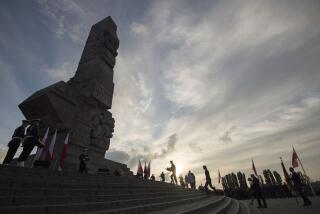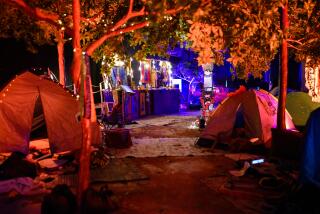Amid bustling Berlin, stillness in the Holocaust Memorial
We were on our way to see the Brandenburg Gate when they came unexpectedly into view across the street — rows of muted gray concrete slabs of varying heights, their rise and fall taking up an entire city block.
The sight stopped us in our tracks.
“That must be the Holocaust Memorial,” I said.
“It can’t possibly be anything else,” said Jon, my husband.
As a Jew, I always have mixed feelings when visiting such places. I am repelled by the horror they represent yet drawn to them for the recognition they offer. What the Germans refer to as a “culture of remembrance” — which acknowledges the crimes of the Nazis and commemorates their victims in more than 100 sites throughout the country — is one reason I’ve come to Berlin.
Overall tourism to Berlin is up 10% this year, with 8 million tourists; visits by Israelis are up even more, by 32%.
Officially, the site is known as the Memorial to the Murdered Jews of Europe. Completed in 2005, according to a design by architect Peter Eisenman, the grid pattern consists of 2,711 unmarked concrete slabs that can be walked around from all sides, leaving visitors to find their own entry and exit points.
The concrete, smooth and cold to the touch, immediately reminded me of coffins and gravestones. I asked one tour guide whether this was intentional. “The architect did not use any symbolism in the design, but intended that each person bring their own interpretation,” she said.
The topside is only half the structure. Below the memorial is an underground exhibit, the Place of Information, accessed from the southeastern corner of the field. Here the particulars of the Nazis’ extermination of the Jews are laid out in five rooms, each with a specific focus.
Although I’m well-versed in the details of Nazi Germany, the Place of Information filled me with foreboding as the introductory hallway outlined, in photographs and text, the developments that led to the Holocaust.
The Room of Dimensions contains personal testimonials, including diary pages, farewell notes and letters written by victims. The documents were placed on the floor in lighted rectangular boxes. I read a postcard thrown from a train by a 12-year-old girl on her way to a concentration camp. It’s addressed to her father, in hopes that someone would find it and forward it to him. She wrote:
“Dear Father, I am saying goodbye to you before I die. We would so love to live, but they won’t let us and we will die…. Goodbye forever. I kiss you tenderly.”
A Dutch farmer did find it, stamped it, and sent it on.
These heartbreaking words provided a personal context for the rest of the exhibits, which include the Room of Families, which focuses on the fates of 15 specific Jewish families; the Room of Names, where names of all known Jewish Holocaust victims obtained from the Yad Vashem memorial in Israel are read out loud, and an exhibit where visitors can hear taped testimonials recorded by survivors of various concentration camps.
Although the Holocaust Memorial focuses on Hitler’s final solution to the Jewish question, across town, the newly expanded Topography of Terror historical site — on the grounds of the former Gestapo and SS headquarters and the Reich Main Security Office where more than 7,000 employees once worked — painfully and precisely documents how the Nazi terror regime functioned.
The new Documentation Center on the site opened in May with the stated purpose of setting up a memorial that does justice to the historical importance of what happened.
The sparse, cube-shaped building by Berlin architect Ursula Wilms is made of open steel and glass and designed to mirror the transparency the site is intended to display. “We tried to find a language of architecture to deal with what happened here,” said Thomas Lutz, one of the center’s staff.
As for the Topography of Terror’s exhibitions, they focus on the central institutions responsible for the crimes the Nazis perpetrated throughout Europe. “Our objective is cold, clear documentation: the opposite of denial. We don’t want to whitewash, but reveal the details of what happened and how it happened,” Lutz said.
A permanent exhibition at the center about the Third Reich is rich in dates and details, addressing with photos and official documents the systematic persecution of Nazi victims, including Jews, homosexuals, Gypsies, the disabled and others.
But even beyond the explicit nature of the permanent exhibition, the site tour brought the cold and calculated terror into a physical reality. At 15 stations around exposed building remnants, placards provide details of the site’s use during the Nazi period and show the exact spots where, over a 12-year period, 12,000 prisoners were interrogated and tortured before being sent to concentration or labor camps. The site also integrates the longest remaining continuous piece of the Berlin Wall, which has been designated a historical monument.
At one point, we stood in a triangle of German history: the interrogation cells before us, the Berlin Wall to the right and a building that housed SS officers to the left. Lutz pointed to the side of the SS building, which is riddled with bullet holes. “Those are from during the war,” he said. “We thought it was important to leave them that way.”
Just over the wall I could see the prosperous and busy shopping street buzzing with afternoon activity, and it hit me that the city has come full circle. Berlin in the golden ‘20s was a cultural center of Europe where Bauhaus architecture, music by Brecht, psychology by Jung and films starring Dietrich thrived. Then came Hitler, the war, communism and a city divided.
Today, Berlin is again pulsating and vibrant. Yet amid the newness and hipness, the bullet holes, the searing photographs and the precise details of Nazi horrors remain ever present. And they should. If nothing else, to remind us to never forget.
More to Read
Sign up for The Wild
We’ll help you find the best places to hike, bike and run, as well as the perfect silent spots for meditation and yoga.
You may occasionally receive promotional content from the Los Angeles Times.






